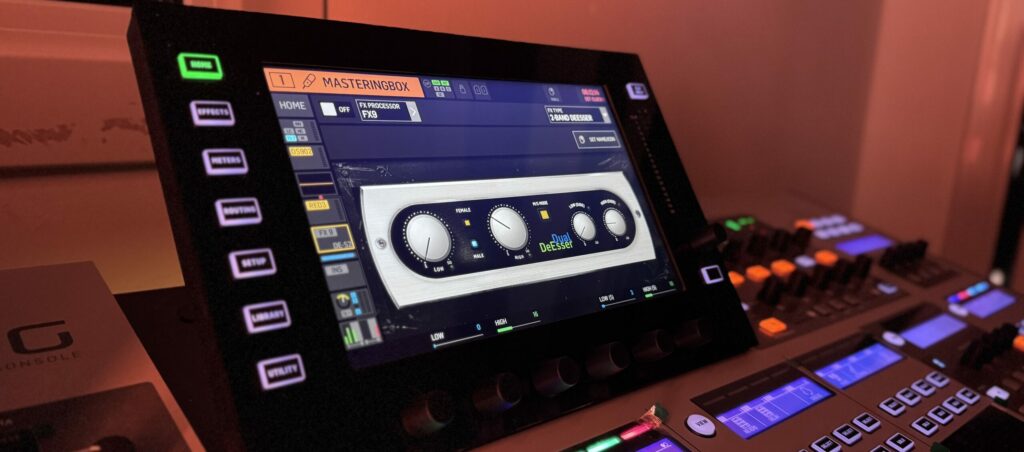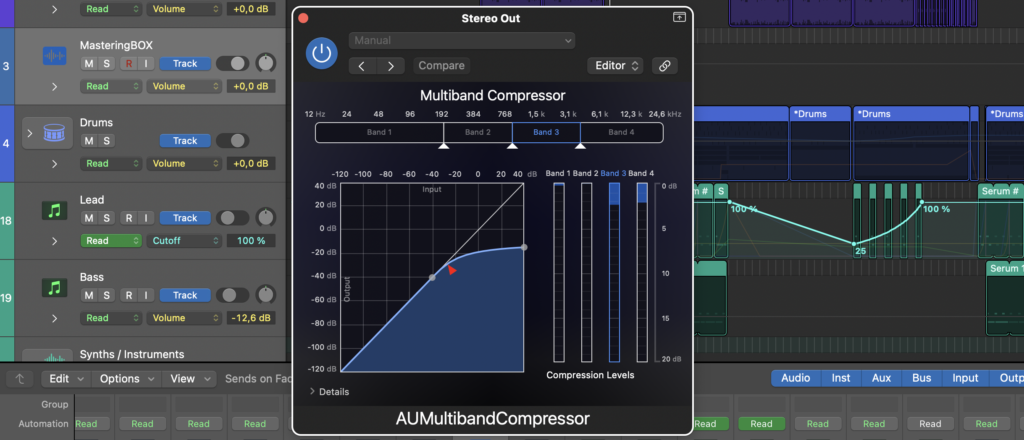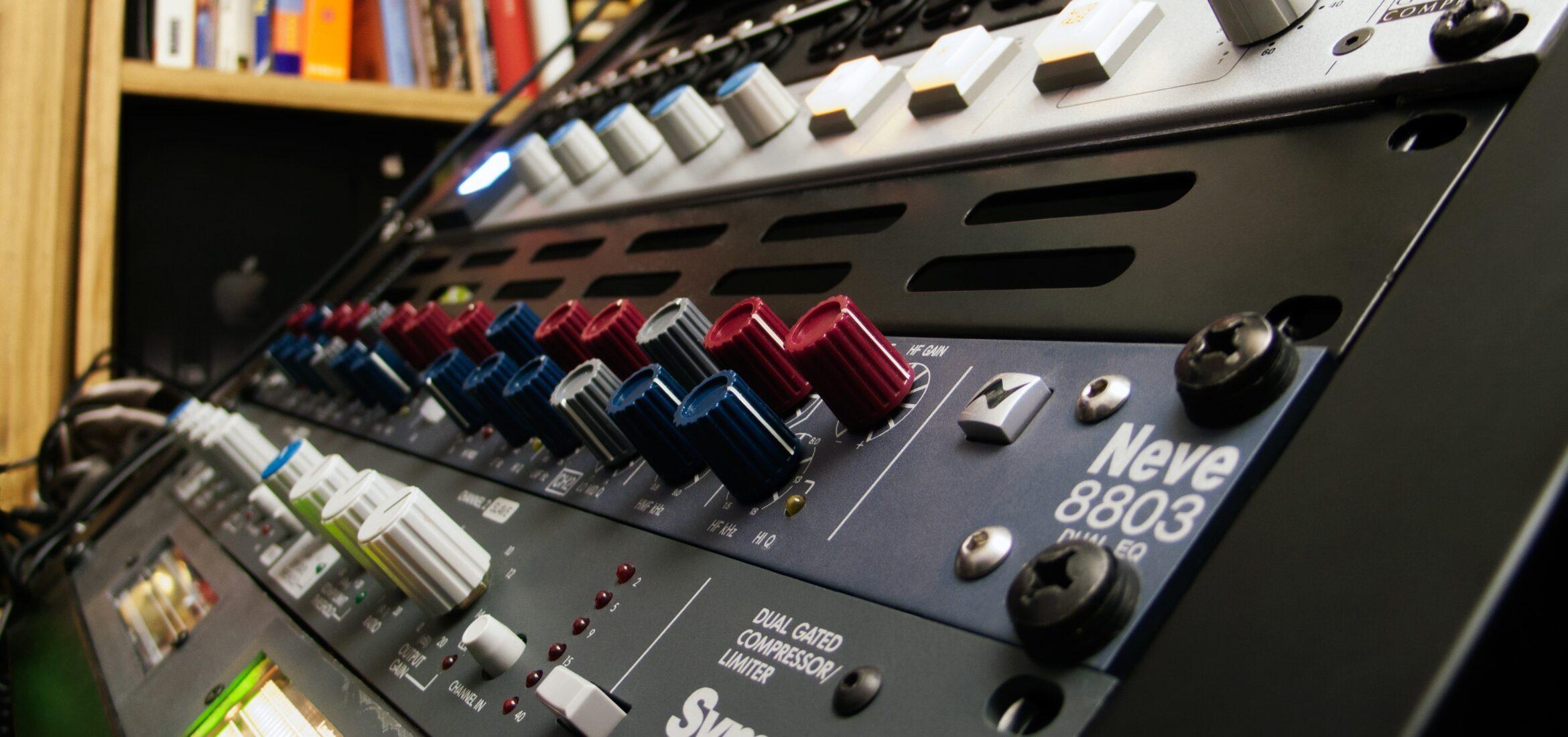Dynamic EQ has emerged as a vital tool in the arsenal of modern music producers, bridging the gap between traditional EQ methods and more advanced techniques like multiband compression. It offers a unique approach to frequency management by allowing specific frequency ranges to be adjusted dynamically based on the input signal’s amplitude. Unlike static EQ, which applies a fixed adjustment to a frequency, dynamic equalization reacts to the audio signal in real-time, making it particularly useful for addressing issues like harshness or muddiness without compromising the overall mix.
Table of Contents
- What is Dynamic EQ?
- Dynamic EQ in Mixing
- Dynamic EQ in Mastering
- Advanced Techniques for Dynamic Equalization
- Final Tips When Using Dynamic EQ
- Conclusion
What is Dynamic EQ?
Dynamic equalization is an advanced audio processing technique that combines equalization and dynamics processing. It uses filters set to specific frequency ranges that respond to the input signal’s amplitude, allowing for real-time adjustments. When the signal exceeds a threshold, it reduces the gain of that frequency band, taming unwanted peaks while maintaining the sound’s character. It enables producers to adjust the gain of specific frequency bands based on the audio signal’s level. This also helps control peaks and resonances while maintaining the mix’s tonal balance.
The main advantage of dynamic EQ is its transparent and musical sound compared to traditional EQ. It effectively addresses problematic frequencies that may arise at specific moments in a track. For instance, a vocal might sound clear in one section but harsh in another. Dynamic EQ intelligently adjusts these frequencies in real time, preserving the performance’s integrity.

Dynamic EQ vs. Traditional EQ
When comparing dynamic EQ to traditional parametric EQ, several key differences emerge. Traditional EQ allows for fixed adjustments to frequency bands. For example, with a parametric equalizer, you can filter or reduce certain frequencies to improve clarity or enhance the individual track. However, because it is a fixed setting, it can lead to issues if the audio signal fluctuates significantly.
Conversely, dynamic EQ provides the flexibility to adapt to these fluctuations, reacting only when necessary. This adaptability allows for more nuanced control over problematic frequencies, resulting in a cleaner mix. Moreover, dynamic EQ can often sound more musical because it maintains the natural dynamics of the audio signal, whereas traditional EQ may inadvertently squash the dynamics when applied aggressively.
When to Use Dynamic Equalization
Dynamic EQ is particularly powerful in scenarios where a frequency problem appears only at certain dynamic levels. Instead of permanently boosting or cutting, you can target issues precisely when and where they occur:
- Vocal Sibilance: De-essing can be thought of as a form of dynamic EQ, focusing on “S” and “T” sounds that spike around 6–8 kHz.
- Resonant Instruments: Instruments like guitars, pianos, or drums may produce unwanted resonances only at specific velocities or playing styles.
- Transient Control: Tightening up transient-heavy sources (e.g., snare drums) in certain frequency regions without affecting the rest of the track’s frequency content.
Examples by Instrument
- Drums: Enhance the punch and clarity of kicks, snares, or toms by taming boomy frequency buildups during louder hits.
- Guitar: Reduce midrange buildup during strumming or distortion-heavy passages, allowing the guitar to sit better in a mix.
- Piano: Manage a broad frequency range to ensure the piano complements rather than competes with vocals or other midrange instruments.
Implementing dynamic EQ in these situations helps producers attain a more refined sound without sacrificing the energy of the performance. This nuanced approach not only enhances the overall clarity of the mix but also contributes to a more engaging listening experience, as each instrument can be heard distinctly and harmoniously within the arrangement.
Dynamic EQ in Mixing
Dynamic equalization can elevate a mix from good to exceptional by ensuring clarity, balance, and musicality. It adapts to the audio signal in real-time, allowing you to fine-tune problem frequencies only when they become an issue. Below are some strategies for using dynamic EQ on various elements in a mix, along with potential pitfalls and additional tips to help you get the most out of this versatile tool.
Vocal Processing with Dynamic Equalization
In vocal processing, dynamic EQ can be a game changer. It allows producers to achieve clarity and balance in vocal mixes by addressing problematic frequencies without compromising the overall sound.
Clarity and Balance
Dynamic equalization can help with clarity and balance in vocals. Here are a few tips to improve your vocal tracks:
- Identify Resonances: Solo the vocal track and sweep with a narrow EQ band to find resonant frequencies (often around 2–4 kHz). Apply dynamic EQ with a moderate ratio and threshold so that the gain reduction kicks in only when the vocal becomes harsh.
- Preserve Warmth: If the low-mid range gets muddy, use a wide dynamic EQ band (around 200–400 Hz) that gently reduces gain when the singer’s voice becomes too boomy or “boxy.”
Natural De-Essing
You can use a de-esser, or you can use a multiband compressor for improved control.
- Focusing on Sibilance: Zero in on the 6–8 kHz range (though sibilance can extend up to 10 kHz in some voices). A moderate threshold ensures only the loudest “S” or “T” sounds trigger gain reduction, maintaining overall brightness.
- Attack and Release Times: Adjust the attack so it responds quickly to sharp sibilant transients, and set a moderate release to avoid abrupt changes in tone.

Enhancing Instrument Separation
Use dynamic EQ to avoid frequency collisions and preserve clarity among multiple instruments, ensuring each element occupies its own sonic space.
Frequency Slotting
Minimize midrange clutter by dynamically reducing overlapping frequencies between instruments, helping each part remain distinct and clear.
- Midrange Clashes: Instruments like guitars, keyboards, and vocals often compete in the midrange (roughly 1–3 kHz). To prevent masking, apply a dynamic cut on the guitar’s midrange band, triggered only when the vocal is present.
- Transitional Elements: If a piano clashes with the lead vocal only during specific phrases, automate or sidechain the piano’s dynamic EQ band to subtly duck the piano each time the vocal hits that range.
Low-End Control
Preserve punch and definition in the lower frequencies by dynamically managing overlapping kick and bass content.
- Bass and Kick Relationship: Low-frequency buildup occurs if the kick and bass occupy the same range (usually around 50–100 Hz). A dynamic EQ on the bass can dip that frequency band when the kick drum is hitting, preserving the definition of each.
- Clean Sub Frequencies: Use a narrow dynamic EQ band for sub-bass (below 50 Hz) if you notice excessive rumble or boominess. Triggering this band only during intense bass notes maintains a full low end without constant EQ cuts.
Additional Applications in Mixing
Beyond individual tracks and basic cleanup, dynamic EQ can be applied in more creative and wide-ranging ways, from group buses to parallel processing to time-based effect returns.
Bus and Group Processing
Applying dynamic EQ at the group or bus level allows you to control collective frequency issues across multiple tracks, unifying the overall sound and maintaining a cohesive mix.
- Glue on the Drum Bus with Subtle Control: Apply multiband compression to the entire drum bus, subtly controlling harsh cymbal peaks or resonant tom frequencies. This keeps the overall drum sound cohesive without over-compressing.
- Collective Build-Up Control: Use a dynamic EQ on a backing vocal group. Tame collective sibilance or midrange buildup that occurs when multiple voices stack at certain frequencies.

Parallel Processing
Using dynamic EQ in parallel lets you blend an effected signal with the original track, offering subtle enhancements or bold creative choices without permanently altering the source.
- Subtle Enhancements with Layered Control: Route a copy of a track to a parallel bus, apply multiband compression to that bus, and blend it in. This retains the raw track’s character while layering in controlled reductions or boosts for problem frequencies.
- Boost and Blend: In parallel, you can also aggressively boost a certain frequency region to add presence or sheen, then dial it back to taste in the main mix.
Handling Time-Based Effects
Reverbs and delays can introduce excessive buildup or harshness in specific frequency ranges. Dynamic EQ on effect returns prevents these issues from overwhelming the mix. If a reverb or delay is causing buildup in the low-mids or harshness in the high-mids, place dynamic equalization on the effect return. This will reduce the problematic frequencies only when the decay becomes too dense or sharp.
Common Mixing Mistakes When Using Dynamic EQ
While dynamic EQ can greatly improve a mix, it’s easy to overdo it and introduce new problems. Knowing the common pitfalls helps you maintain a natural sound and keep your mix coherent.
Over-Processing
Applying dynamic EQ too liberally can strip the track of its life. Subtlety and precision are key to retaining the intended character of each element in a mix.
- Hollow Tonal Balance: Applying compression across too many bands can remove the natural character of a track. Always aim for subtlety; small reductions where needed are often enough to clean up problem spots.
- Masking Other Issues: Dynamic EQ isn’t a cure-all. If a track is poorly recorded or overly compressed, using it on every frequency problem can lead to a lack of cohesion.
Aggressive Threshold Settings
Setting thresholds too low or ratios too high can cause unnatural effects, from pumping artifacts to a wavering timbre, ultimately detracting from the musicality of the mix.
- Pumping and Artifacts: An excessively low threshold or a high ratio can cause the signal to “pump.” This not only draws attention to the EQ processing but can also thin out the mix in those frequency areas.
- Inconsistent Timbre: If your threshold is too sensitive, frequent gain changes in the same band can create a wavering tone, making an instrument or vocal sound unnatural.
Dynamic EQ in Mastering
Dynamic EQ also serves as a valuable tool in the mastering stage, where subtle yet critical adjustments can significantly impact the final presentation of a track. Because mastering focuses on the final stereo mix rather than individual tracks, dynamic equalization applied at this stage must be used judiciously to address broad or global frequency issues without compromising the musicality or overall balance achieved in the mix.
Preparing a Mix for Mastering
When preparing a mix for mastering, you can use dynamic EQ to solve broadband problematic frequencies, do gentle tonal shaping, and increase consistency between tracks.
Reduce Broadband Problematic Frequencies
If certain frequencies (such as overly harsh highs around 5–8 kHz or boxy mids around 200–400 Hz) consistently jump out, a multiband compressor can tame them without permanently dulling the entire track. This ensures you’re only applying reduction when problem frequencies exceed a threshold, leaving the rest of the spectrum relatively untouched.

Gentle Tonal Shaping
Dynamic EQ can be used to impart a final shape or polish. For instance, you might subtly boost low-end or upper-midrange frequencies, but only when the signal level drops below certain thresholds, preserving transients and preventing excessive buildup.
Consistency Across the Album/Project
When mastering multiple tracks for an EP or album, dynamic equalization can help maintain consistency by applying similar thresholds and gain ranges to tame or enhance specific frequency zones across all songs.
Dynamic EQ for Frequency Balancing
While a traditional static EQ could achieve a general curve, dynamic EQ allows for reactive control:
- Targeting ‘Roaming’ Frequencies: Some tracks exhibit erratic frequency spikes that show up only during loud passages or specific transitions. Setting a moderate threshold (e.g., –6 dB to –10 dB of gain reduction at peaks) ensures these spikes are reined in without permanently carving out frequencies across the whole song.
- De-Essing at the Mastering Stage: Harsh sibilance can sometimes slip through the mixing process, especially in busier mixes. Using a dedicated band around 5–8 kHz (or higher for air-range issues) with fast attack and moderate release can prevent harsh consonants from dominating. Be careful not to overly dull the top end; aim for subtlety in the thresholds, and check the results on various playback systems to ensure you’re not killing the track’s brightness.
- Subtle Low-End Management: Overly boomy or resonant subs (below ~50–60 Hz) can cause playback issues on certain speaker systems. A narrow dynamic EQ band that reduces gain only when sub-frequencies exceed a threshold helps maintain a controlled yet punchy low end.
Avoiding Mastering Pitfalls with Dynamic EQ
Dynamic EQ provides great flexibility, but mastering calls for precision and restraint. Make sure to avoid these common mistakes.
Over-Compression of Frequency Bands
High ratios (e.g., above 4:1) or extremely low thresholds can cause the track to “pump” or “breathe” in an unmusical way. A general rule is to keep ratios between 1.5:1 and 3:1 in mastering to maintain transparency.
Phase Interactions
Depending on the plugin type (linear-phase vs. minimum-phase), dynamic EQ can introduce latency or phase shifts. In mastering, linear-phase filters are often preferred to avoid phase smear, especially when working with stereo material.
Inconsistent Loudness and Dynamics
Check your loudness metering (LUFS, RMS) before and after dynamic EQ to ensure you’re not inadvertently adding or removing significant energy in certain bands. Sometimes a small gain match (±0.5 dB) post-processing helps maintain consistent loudness for fair A/B comparisons.
Loss of Musicality
If you apply dynamic EQ too aggressively, you risk flattening the natural ebb and flow of the song. Always verify that the track retains its musical dynamics. Listen to soft verses and loud choruses to confirm the EQ remains transparent and supportive.
Advanced Techniques for Dynamic Equalization
For those looking to take their dynamic EQ skills to the next level, advanced techniques can unlock new creative possibilities. This section highlights innovative applications of dynamic EQ, including creative uses and automation strategies that can enhance the overall production process.
Creative Uses
Dynamic EQ can be employed in various creative ways beyond traditional applications. Producers can use it to create dynamic frequency sweeps, enhancing the movement and interest within a track. Additionally, dynamic EQ can be used to emphasize specific elements during key moments in a song, allowing for greater expressiveness and impact.
Automation
Automation is another powerful technique that can be used in conjunction with dynamic EQ. By automating dynamic EQ settings, producers can enhance musical expressiveness and create more engaging mixes. This could involve adjusting thresholds or gain levels in real-time to match the dynamics of the performance, ensuring that each element of the mix is heard at the right moment.
Final Tips When Using Dynamic EQ
- Monitor in Context: Continuously A/B test between the processed and unprocessed versions at matched loudness. Subtle shifts in tonality can have a larger effect once they’re the only changes in a final master.
- Use Narrow Q for Precision: When taming a resonant frequency, a narrower Q will let you precisely target the problem area. However, if the resonant peak is broad, gently widening the Q can provide a smoother, more natural reduction.
- Frequency-Specific Transient Preservation: If certain transient elements (like a snare fundamental) get lost when a band engages, slightly increase the attack time or lower the ratio to preserve the snappiness.
- Check Multiple Playback Systems: A dynamic EQ setting that sounds perfect on near-field monitors might shift the balance on smaller devices or headphones. Always cross-reference to ensure your final decisions translate well.

By leveraging dynamic EQ in the mixing and mastering process with restraint and precision, you can preserve the natural dynamics of a mix while still making vital frequency tweaks. This approach ensures the track remains cohesive and musical, meeting the professional standards expected for final distribution.
Conclusion
In summary, dynamic EQ is an essential tool for both mixing and mastering, offering a versatile approach to frequency management that traditional methods cannot match. By understanding its mechanics and applications, producers can effectively utilize dynamic EQ to enhance their mixes and achieve professional-sounding results. The techniques discussed throughout this article provide a solid foundation for experimenting with dynamic EQ, encouraging readers to explore its potential in their music production endeavors. Whether addressing specific frequency issues or enhancing the overall clarity of a mix, dynamic EQ is an invaluable asset in the quest for sonic excellence.
À propos de l'auteur

Dídac
PDG et fondateur de MasteringBOXDídac est un ingénieur audio professionnel, un producteur de musique et un ingénieur logiciel. Il est le fondateur de MasteringBOX et l'auteur de nombreux articles sur le blog.
Laisse un commentaire
Connecte-toi pour commenter.


